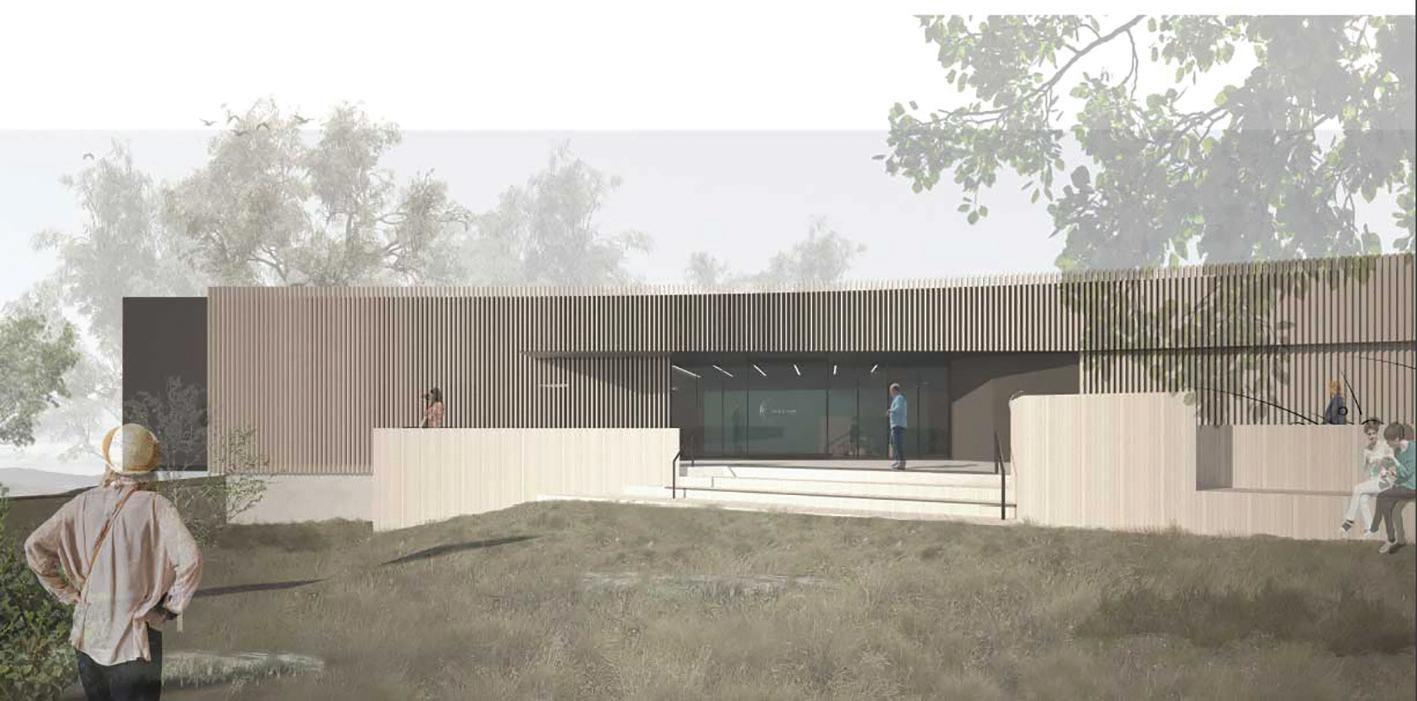
5 minute read
Development of a sustainable spiny lobster aquaculture industry
Anna Overweter and Scott Parkinson, Ornatas and Greg Smith, IMAS-UTAS
Figure 1. Artist impression of the world’s first lobster pilot hatchery to be constructed in Tasmania. Photo credit: Ornatas.
Ornatas Pty Ltd, a wholly-owned Tasmanian company, was established in 2018 expressly to create the world’s first tropical rock lobster (Panulirus ornatus) and Moreton Bay bug (Thenus australiensis) industry for Australian and international markets. Over the next ten years, over AU$55 million will be invested in the development of this new hi-tech aquaculture industry co-located in Tasmania and Queensland. Ornatas will use groundbreaking science developed by the University of Tasmania (UTAS) - Institute for Marine and Antarctic Studies (IMAS) to recreate the complex oceanic environment that allows high-density culture of the planktonic larval phase of spiny lobsters. The technology is truly the holy grail of aquaculture and does what so many have tried and failed at before – commercial production of tropical rock lobster (TRL) and Moreton Bay bug (MBB) to a marketable size. Ornatas is in the first year of its ten-year growth plan and by 2030 is targeting a total production of 1,100 tons of TRL and 150 tons of MBB.
State-of-the-art hatchery and research center
In April 2020, Ornatas submitted a development application to build a pilot-scale TRL hatchery (Fig. 1) in Tasmania. The AU$10 million state-of-the-art hatchery and research center of excellence will be co-located with their research partners IMAS. The fully bio-secure hatchery is a scalable pilot facility designed for future expansion in QLD when full commercialization of the technology has been realized. The facility consists of broodstock quarantine systems for holding newly imported breeders and three broodstock production systems to give yearround supply of larvae into the hatchery. There will be two larval rearing recirculation systems, each operating seven 10,000 L tanks. In full production, the facility will produce 500,000 juveniles per year. The facility also includes dedicated feed manufacturing and research laboratories as well as recirculation aquaculture plant rooms. The larval phase of lobster culture will be undertaken in Tasmania, with post
Figure 2. Newly metamorphosed spiny lobster puerulus, the intermediate phase between the larval and juvenile stages of development. Photo credit: Ornatas.

metamorphosis puerulus (Fig. 2) and juveniles shipped to our Townsville site in northern Queensland where they will be cultured in onshore systems to market size.
The Townsville site is home to the companies Moreton Bay Bug hatchery and nursery facility, commissioned in March 2020. The Brownfield site is being redeveloped after 30 years of prawn and barramundi farming into a contemporary, high-end technology and sustainable aquaculture farm. They are currently undertaking a second Moreton Bay bug larval run after a successful commissioning phase though the early part of 2020.
20 years of IMAS research
The research that Ornatas is commercializing has been many years in the making. More than 20 years of spiny lobster propagation research has been undertaken at IMAS, with many more years in laboratories in Japan (Kittaka, 1988). There were several technical issues to overcome to allow lab-based success to be translated into commercial processes, primarily centered on developing nutrition, health and culture system solutions. During the past ten years, IMAS has been focused on providing commercial solutions to each of these technical issues. The advent of a complete diet for the larval phase more than five years ago was a significant breakthrough in the provision of adequate nutrition for larval rearing but also provided significant health benefits to larvae. The development of specially engineered large passive flow culture vessels (10,000 L) that minimize larval damage and optimize larval and feed interactions, combined with water treatment systems that make extensive use of ozone (Ritar et al., 2006) provides optimal conditions to rear this long lived larval planktonic phase.
Developing commercial lobster industry
Recently Ornatas and UTAS received an enormous boost to support the development of an onshore lobster grow-out industry with the awarding of an Australian Research Council Research Hub for Sustainable Onshore Lobster Aquaculture, worth a total of $26 million over the next five years. Ornatas has invested AU$5 million in this partnership matching the federal government’s contribution to the project, while the other partners in the project, UTAS, the University of the Sunshine Coast, the University of Auckland and PFG Group have invested a further AU$16 Million in cash and in-kind contributions.
The ARC project will address industry transformation by delivering key biological, industrial, environmental and social priorities in partnership with industry. Several key components enabling the establishment of a successful onshore lobster aquaculture industry will be addressed by targeted PhD studies, particularly in the molecular, health and social science fields. Technology transfer and training activities, including staff
Figure 3. Phyllosoma stage of spiny lobster. Photo credit: Ornatas.
exchanges, student placements and the participation of research and partner staff in focused training courses will be key to the project’s success.
There is a strong academic and technical team of 25 researchers working at IMAS on the project to address the five key research areas. This research is allowing Ornatas to realize their full potential and create a commercial lobster industry in Australia.
Ornatas envisions at end of the ten-year model, to have developed a new lobster aquaculture sector in Australia worth in excess of AU$500 million per year with 120 direct employees and supporting 1000 indirect jobs, with an annual company turnover of AU$163 million dollars.
References
Kittaka, J. 1988. Culture of the Palinurid Jasus lalandii from egg stage to puerulus. Nippon Suisan Gakk., 54: 87-93. Ritar, AJ, Smith, GG, Thomas, CW. 2006. Ozonation of seawater improvise the survival of larval southern rock lobster, Jasus edwardsii, in culture from egg to juvenile. Aquaculture, 261: 1014-1025.
Anna Overweter
Hatchery Manager Ornatas, Australia E: annao@ornatas.com.au

Scott Parkinson
CEO Ornatas, Australia
More information: Greg Smith
Professor University of Tasmania, Australia










